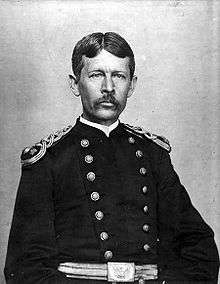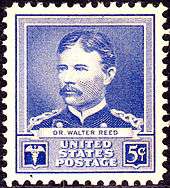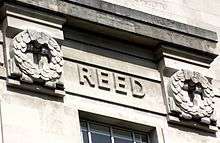Walter Reed
Major Walter Reed, M.D., U.S. Army (September 13, 1851 – November 22, 1902), was a U.S. Army physician who in 1901 led the team that confirmed the theory of the Cuban doctor Carlos Finlay that yellow fever is transmitted by a particular mosquito species, rather than by direct contact. This insight gave impetus to the new fields of epidemiology and biomedicine, and most immediately allowed the resumption and completion of work on the Panama Canal (1904–1914) by the United States. Reed followed work started by Carlos Finlay and directed by George Miller Sternberg, who has been called the "first U.S. bacteriologist".
Walter Reed | |
|---|---|
 Walter Reed | |
| Born | September 13, 1851 Gloucester County, Virginia, U.S. |
| Died | November 22, 1902 (aged 51) Washington, D.C. |
| Buried | (Section 3, Lot 1864 Grid T/U-16.5 - Arlington National Cemetery) |
| Allegiance | United States |
| Service/ | United States Army |
| Years of service | 1876–1902 |
| Rank | Major |
| Alma mater | University of Virginia New York University Johns Hopkins University |
| Spouse(s) | Emilie Lawrence (m. 1876) |
| Children | Walter Lawrence Reed (born December 4, 1877, Ft. Apache) Emilie Reed (called Blossom) (born July 12, 1883, Ft. Omaha) Susie Reed (adopted aboriginal American child) |
Early and family life
Walter Reed was born in Belroi, Virginia, to Lemuel Sutton Reed (a traveling Methodist minister) and his first wife, Pharaba White.[1] During his youth, the family resided at Murfreesboro, North Carolina with his mother's family during his father's preaching tours. Two of his elder brothers later achieved distinction: J.C. became a minister in Virginia like their father, and Christopher a judge in Wichita, Kansas and later St. Louis, Missouri,[2] Their childhood home is included in the Murfreesboro Historic District.[3]
After the American Civil War, Rev. Reed remarried, to Mrs. Mary C. Byrd Kyle of Harrisonburg, Virginia, with whom he would have a daughter. Young Walter enrolled at the University of Virginia. After two years, Reed completed the M.D. degree in 1869, two months before he turned 18. He was the youngest-ever recipient of an M.D. from the university.[4]
Reed then enrolled at the New York University's Bellevue Hospital Medical College in Manhattan, New York, where he obtained a second M.D. in 1870, as his brother Christopher attempted to set up a legal practice. After interning at several New York City hospitals, Walter Reed worked for the New York Board of Health until 1875.
He married Emily Blackwell Lawrence (1856–1950) of North Carolina on April 26, 1876 and took her West with him. Later, Emily would give birth to a son, Walter Lawrence Reed (1877–1956) and a daughter, Emily Lawrence Reed (1883–1964), and the couple also adopted an aboriginal American girl while posted at frontier camps.[5]
U.S. Army Medical Corps
Finding his youth limited his influence, and dissatisfied with urban life,[6] Reed joined the U.S. Army Medical Corps. This allowed him both professional opportunities and modest financial security to establish and support a family. After Reed passed a grueling thirty-hour examination in 1875, the army medical corps enlisted him as an assistant surgeon. By this time, two of his brothers were working in Kansas, and Walter soon was assigned postings in the American West. Over the next sixteen years, the Army assigned the career officer to different outposts, where he was responsible not only for American military and their dependents, but also various aboriginal American tribes, at one point looking after several hundred Apaches, including Geronimo. Reed noticed the devastation epidemics could wreak and maintained his concerns about sanitary conditions. During one of his last tours, he completed advanced coursework in pathology and bacteriology in the Johns Hopkins University Hospital Pathology Laboratory.
While stationed at Fort Robinson, Nebraska, Reed treated the ankle of Swiss immigrant Jules Sandoz, broken by a fall into a well. Reed wanted to amputate Sandoz's foot, but Sandoz refused his consent, and Reed succeeded in saving the foot by an extensive course of treatment. A photograph of a letter from Reed to Sandoz's father is reproduced in the first edition of Old Jules, the 1935 biography of Sandoz by his daughter Mari Sandoz.
In 1893, Reed joined the faculty of the George Washington University School of Medicine and the newly opened Army Medical School in Washington, D.C., where he held the professorship of Bacteriology and Clinical Microscopy. In addition to his teaching responsibilities, he actively pursued medical research projects and served as the curator of the Army Medical Museum, which later became the National Museum of Health and Medicine (NMHM). These positions also allowed Reed to break free from the fringes of the medical world
In 1896, Reed first distinguished himself as a medical investigator. He proved that yellow fever among enlisted men stationed near the Potomac River was not a result of drinking the river water. He showed officials that the enlisted men who got yellow fever had a habit of taking trails through the local swampy woods at night. Their yellow fever-free fellow officers did not do so. Reed also proved that the local civilians drinking from the Potomac River had no relation to the incidence of the disease.[7]
Reed traveled to Cuba to study diseases in U.S. Army encampments there during the Spanish–American War. Appointed chairman of a panel formed in 1898 to investigate an epidemic of typhoid fever, Reed and his colleagues showed that contact with fecal matter and food or drink contaminated by flies caused that epidemic. Yellow fever also became a problem for the Army during this time, felling thousands of soldiers in Cuba.
In May 1900, Major Reed returned to Cuba when he was appointed head of the Army board charged by Surgeon General George Miller Sternberg to examine tropical diseases, including yellow fever. Sternberg was one of the founders of bacteriology during this time of great advances in medicine due to widespread acceptance of Louis Pasteur's germ theory of disease, as well as the methods of studying bacteria developed by Robert Koch. During Reed's tenure with the U.S. Army Yellow Fever Commission in Cuba, the board both confirmed the transmission by mosquitoes and disproved the common belief that yellow fever could be transmitted by clothing and bedding soiled by the body fluids and excrement of yellow fever sufferers – articles known as fomites. The board conducted many of its dramatic series of experiments at Camp Lazear, named in November 1900 for Reed's assistant and friend Jesse William Lazear, who had died two months earlier of yellow fever while on this assignment.
The risky but fruitful research work was done with human volunteers, including some of the medical personnel, such as Clara Maass, who allowed themselves to be deliberately infected. The research work with the disease under Reed's leadership was largely responsible for stemming the mortality rates from yellow fever during the building of the Panama Canal, something that had confounded the French attempts in that region only 20 years earlier.
Although Reed received much of the credit in history books for "beating" yellow fever, Reed himself credited Carlos Finlay with the discovery of the yellow fever vector, and thus how it might be controlled. Reed often cited Finlay's papers in his own articles and gave him credit for the discovery, even in his personal correspondence. The Cuban physician was a strong advocate of the transmission theory as the cause of yellow fever and discovered the type of mosquito that transmits yellow fever. His unsophisticated experiments that proved this were discounted by many, but were the basis of Reed's research.[8]
After Reed returned from Cuba in 1901, he continued to speak and publish on yellow fever. He received honorary degrees from Harvard and the University of Michigan in recognition of his seminal work.
In November 1902, Reed's appendix ruptured. He died on November 22, 1902, of the resulting peritonitis, at age 51. He is buried in Arlington National Cemetery.[9]
Legacy

Reed's breakthrough in yellow fever research is widely considered a milestone in biomedicine, opening new vistas of research and humanitarianism. It was largely an extension of Carlos J. Finlay's work, carried out during the 1870s in Cuba, which finally came to prominence in 1900. Finlay was the first to theorize, in 1881, that a mosquito was a carrier, now known as a disease vector, of the organism causing yellow fever: a mosquito that bites a victim of the disease could subsequently bite and thereby infect a healthy person. He presented this theory at the 1881 International Sanitary Conference, where it was well-received. A year later Finlay identified a mosquito of the genus Aedes as the organism transmitting yellow fever. His theory was followed by the recommendation to control the mosquito population as a way to control the spread of the disease.
His hypothesis and exhaustive proofs were confirmed nearly twenty years later by the Walter Reed Commission of 1900. Although Reed received much of the credit in history books for "beating" yellow fever, Reed himself credited Finlay with the discovery of the yellow fever vector, and thus how it might be controlled. Reed often cited Finlay's papers in his own articles and gave him credit for the discovery in his personal correspondence. In the words of General Leonard Wood, a physician and U.S. military governor of Cuba in 1900: "The confirmation of Finlay's doctrine is the greatest step forward made in medical science since Jenner's discovery of the vaccination for smallpox."
This discovery helped William C. Gorgas reduce the incidence and prevalence of mosquito-borne diseases in Panama during the American campaign, from 1903 onwards, to construct the Panama Canal. Prior to this, about 10% of the workforce had died each year from malaria and yellow fever.
In 1912, he posthumously received what would come to be known as the Walter Reed Medal in recognition of his work to combat yellow fever. A tropical medicine course is also named after him, Walter Reed Tropical Medicine Course. The National Library of Medicine in Bethesda, Maryland holds a collection of his papers regarding typhoid fever studies.[10] Philip Showalter Hench, a Nobel Prize winner for Physiology or Medicine in 1950, maintained a long interest in Walter Reed and yellow fever. His collection of thousands of items—documents, photographs, and artifacts—is at the University of Virginia in the Philip S. Hench Walter Reed Yellow Fever Collection.[11] More than 7,500 of these items, including several hundred letters written by Reed himself, are accessible online at the web exhibit devoted to this Collection.[12]
In addition to that medal, course, and a stamp issued in his honor (shown), locations and institutions named after the medical pioneer include:
- Walter Reed General Hospital (WRGH), Washington, D.C. was opened on May 1, 1909, seven years after his death.
- Reed Hall at Radford College (now Radford University) was constructed in 1939 as the original home for the sciences and named for Dr. Walter Reed. It is now part of the Artis College for Science and Technology at Radford.[13]
- Walter Reed Army Medical Center (WRAMC) opened in 1977 as the successor to WRGH and closed in 2011; it was the worldwide tertiary care medical center for the U.S. Army and was utilized by congressmen and presidents.
- Walter Reed Army Institute of Research (WRAIR), near Washington, D.C., is the largest biomedical research facility administered by the DoD and successor to the Army Medical School.
- Walter Reed Biosystematics Unit, operating under the direction of the Walter Reed Army Institute of Research conducting research on the systematics of medically important arthropods.
- Walter Reed National Military Medical Center, a new hospital complex constructed on the grounds of the National Naval Medical Center, Bethesda, Maryland, dedicated in 2011.
- Walter Reed Birthplace, added to the National Register of Historic Places in 1973.[14]
- Riverside Walter Reed Hospital in Gloucester, Virginia (near Reed's birthplace) opened on September 13, 1977.
- Arlington County, Virginia has two facilities named for Reed: the Reed School in Westover and a community/senior center near Walter Reed Drive in Arlington Village.
- Walter Reed Middle School, North Hollywood, California is named in Reed's honor.
- Walter Reed Army Medical Center Firefighters Washington D.C. IAFF F151
- Reed appears in sculpture on the great stone chancel screen at Riverside Church, NYC. (Section 4: "Humanitarians", rather than Section 1: "Physicians".)

Lewis Stone portrayed Reed in the 1938 Hollywood movie Yellow Jack. The same story line was again presented in television episodes (both titled "Yellow Jack") of Celanese Theatre (1952) and of Producers' Showcase (1955); in the latter, Reed was portrayed by Broderick Crawford. In an episode of the anthology show Death Valley Days from 1962 entitled "Suzie" Jeffrey Hunter played him. PBS's American Experience series broadcast a 2006 episode, "The Great Fever", on Reed's yellow fever campaign.
Reed's name features on the Frieze of the London School of Hygiene & Tropical Medicine. Twenty-three names of public health and tropical medicine pioneers were chosen to feature on the School building in Keppel Street when it was constructed in 1926.[15]
See also
- Human experimentation in the United States
References
Citations
- Methodist Episcopal Church. South. The Virginia Conference Annual (1898) pp. 30-31 available at Google books https://books.google.com/books?id=h4Y9AAAAYAAJ&pg=PA31&lpg
- A.D.J. Stewart, History of the Bench and Bar of Missouri (Legal Publishing Company 1898), p. 293 available at Google Book at shttps://books.google.com/books?id=eXomAQAAMAAJ&pg=PA293&lpg
- John B. Wells, III (November 1970). "Murfreesboro Historic District" (PDF). National Register of Historic Places – Nomination and Inventory. North Carolina State Historic Preservation Office. Retrieved 2015-01-01.
- Pierce J.R., J, Writer. 2005. Yellow Jack: How Yellow Fever Ravaged America and Walter Reed Discovered its Deadly Secrets. John Wiley and Sons. ISBN 0-471-47261-1
- Crosby, Molly Caldwell (2006). The American Plague: The Untold Story of Yellow Fever, the Epidemic that Shaped Our History, p. 134. New York: Berkley Books. ISBN 0-425-21202-5
- The Great Fever / People & Events / Walter Reed at pbs.org
- "Walter Reed". American History. ABC-CLIO. 2013. Retrieved 23 January 2013.
- "Reed Discovers the Cause of Yellow Fever". Great Scientific Achievements. Salem Press. 1999: History Reference Center. Cite journal requires
|journal=(help) - Arlington Cemetery
- "Walter Reed Papers 1888–1972". National Library of Medicine.
- "A Guide to the Philip S. Hench Walter Reed Yellow Fever Collection". University of Virginia Health Sciences Library.
- "Philip S. Hench Walter Reed Yellow Fever Collection". University of Virginia Health Sciences Library.
- "CSATnewsletter10-28-16.pdf" (PDF). Retrieved 17 October 2017.
- "National Register Information System". National Register of Historic Places. National Park Service. July 9, 2010.
- "Behind the Frieze". LSHTM. Archived from the original on 2017-02-22. Retrieved 21 February 2017.
Further reading
- Bean, William B., Walter Reed: A Biography, Charlottesville: University Press of Virginia, 1982.
- Bean, William B., "Walter Reed and Yellow Fever", JAMA 250.5 (August 5, 1983): 659–62.
- Pierce J.R., (2005). Yellow Jack: How Yellow Fever Ravaged America and Walter Reed Discovered its Deadly Secrets. John Wiley and Sons. ISBN 0-471-47261-1
External links
- Video: Reed Medical Pioneers Biography on Health.mil – The Military Health System provides a look at the life and work of Walter Reed.
- WRAMC Website Reed History
- WRAIR Website Reed History
- University of Virginia, Philip S. Hench – Walter Reed Yellow Fever Collection: Walter Reed Biography
- University of Virginia, Yellow Fever and the Reed Commission: The Walter Reed Commission
- University of Virginia, Walter Reed Typhoid Fever, 1897-1911